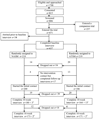Costs of novel symptom management interventions and their impact on hospitalizations
- PMID: 20413054
- PMCID: PMC2859211
- DOI: 10.1016/j.jpainsymman.2009.07.014
Costs of novel symptom management interventions and their impact on hospitalizations
Abstract
Four hundred thirty-seven patients with solid tumor cancer, undergoing chemotherapy, were enrolled, interviewed, and randomized to receive either a six-contact, eight-week, nurse-directed intervention or an automated telephone symptom management intervention. Patients were assessed at 10 and 16 weeks. Patients were queried at intake and at 10 and 16 weeks to determine the severity of their symptoms and if they had been hospitalized-if hospitalized, the number of hospitalizations and location of the hospital. The fixed and variable costs associated with the production of each arm were identified. Both total fixed and variable costs were greater for the nurse arm; total costs per patient were $69 and $167 for the automated and nurse arms, respectively. The overall symptom severity declined significantly over baseline and equally between the groups at 10 and 16 weeks. The relationship between reductions in symptom severity and the number of hospitalizations and days in the hospital was investigated using zero-inflated Poisson regression model. The cost of a hospitalization was estimated at $1,800 per day in 2004. At 16 weeks, those with 50% or greater reductions in severity had an adjusted mean of 1.1 days in the hospital, whereas those with increased symptom severity had a mean of 2.23. Reductions in hospitalizations related to lower severity suggest that the telephone arm could produce a net saving over cost of its development and implementation. Although promising, the links between reductions in severity of symptoms and fewer hospitalizations remain difficult to isolate.
Copyright (c) 2010 U.S. Cancer Pain Relief Committee. Published by Elsevier Inc. All rights reserved.
Figures

Similar articles
-
Relationship between glycemic control and diabetes-related hospital costs in patients with type 1 or type 2 diabetes mellitus.J Manag Care Pharm. 2010 May;16(4):264-75. doi: 10.18553/jmcp.2010.16.4.264. J Manag Care Pharm. 2010. PMID: 20433217 Free PMC article.
-
Symptom management for cancer patients: a trial comparing two multimodal interventions.J Pain Symptom Manage. 2007 Sep;34(3):253-64. doi: 10.1016/j.jpainsymman.2006.11.018. Epub 2007 Jul 9. J Pain Symptom Manage. 2007. PMID: 17618080 Free PMC article. Clinical Trial.
-
Differential symptom reporting by mode of administration of the assessment: automated voice response system versus a live telephone interview.Med Care. 2009 Aug;47(8):866-74. doi: 10.1097/MLR.0b013e3181a31d00. Med Care. 2009. PMID: 19584761 Free PMC article. Clinical Trial.
-
Telephone interventions for symptom management in adults with cancer.Cochrane Database Syst Rev. 2020 Jun 2;6(6):CD007568. doi: 10.1002/14651858.CD007568.pub2. Cochrane Database Syst Rev. 2020. PMID: 32483832 Free PMC article.
-
Folic acid supplementation and malaria susceptibility and severity among people taking antifolate antimalarial drugs in endemic areas.Cochrane Database Syst Rev. 2022 Feb 1;2(2022):CD014217. doi: 10.1002/14651858.CD014217. Cochrane Database Syst Rev. 2022. PMID: 36321557 Free PMC article.
Cited by
-
Healthcare service utilization and work-related productivity in reflexology intervention for advanced breast cancer women.Support Care Cancer. 2019 Aug;27(8):2837-2847. doi: 10.1007/s00520-018-4592-4. Epub 2018 Dec 14. Support Care Cancer. 2019. PMID: 30552595 Free PMC article. Clinical Trial.
-
Does value mean quality? The payer's perspective.J Oncol Pract. 2013 May;9(3):116-8. doi: 10.1200/JOP.2013.001017. J Oncol Pract. 2013. PMID: 23942484 Free PMC article.
-
A Sequential Multiple Assignment Randomized Trial of Symptom Management After Chemotherapy.J Pain Symptom Manage. 2023 Jun;65(6):541-552.e2. doi: 10.1016/j.jpainsymman.2023.02.005. Epub 2023 Feb 17. J Pain Symptom Manage. 2023. PMID: 36801353 Free PMC article. Clinical Trial.
-
Testing the differential effects of symptom management interventions in cancer.Psychooncology. 2015 Jan;24(1):25-32. doi: 10.1002/pon.3555. Epub 2014 Apr 15. Psychooncology. 2015. PMID: 24737669 Free PMC article. Clinical Trial.
-
Economic evaluation of a farm-to-Special Supplemental Nutrition Programme for Women, Infants and Children intervention promoting vegetable consumption.Public Health Nutr. 2021 Aug;24(12):3922-3928. doi: 10.1017/S1368980021001981. Epub 2021 May 11. Public Health Nutr. 2021. PMID: 33972002 Free PMC article.
References
-
- Butler AC, Chapman JE, Forman EM, Beck AT. The empirical status of cognitive behavioral therapy: a review of meta-analysis. Clin Psychol Rev. 2006;26:17–31. - PubMed
-
- Newell SA, Sanson-Fisher RW, Savolainen NJ. Systematic review of psychological therapies for cancer patients: overview and recommendations for future research. J Natl Cancer Inst. 2002;94:558–584. - PubMed
-
- Jacobsen P, Meade C, Stein K, et al. Efficacy and costs of two forms of stress management training for cancer patients undergoing chemotherapy. J Clin Oncol. 2002;20:2851–2862. - PubMed
-
- Given C, Given B, Rahbar M, et al. Effect of a cognitive behavioral intervention on reducing symptom severity during chemotherapy. J Clin Oncol. 2004;22:507–516. - PubMed
-
- Yates P, Aranda S, Hargraves M, et al. Randomized controlled trial of an educational intervention for managing fatigue in women receiving adjuvant chemotherapy. J Clin Oncol. 2005;23:6027–6036. - PubMed
Publication types
MeSH terms
Grants and funding
LinkOut - more resources
Full Text Sources
Medical

